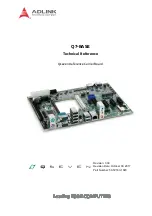
page 6 of 8
XJTAG-3030-Guide-20C-01
www.xjtag.com
SPEA 3030 XJLink2 Carrier Board
.
User Guide
6. XJDeveloper Project Requirements
To use an XJLink2-3030 module in the Carrier Board to run boundary scan tests, the XJDeveloper project
must control the relays at the start of the test sequence in order to make the connections between the UUT
and the module.
The relay connections are activated when the function of pin 1 of the XJLink2-3030 is set to be “
Power On
”.
This is configured on the pin mapping screen in XJDeveloper.
This means that pin 1 cannot be used for any other function. It should also be noted that although IOx_01
signals are brought out to the system connector these pins are is currently reserved for future use; they
will not be driven high and cannot be used to supply any power to the UUT.
Pin 11 must not be used for its
Power On
function. On the XJLink2-3030 module this function is again
reserved for future use, it will not cause pin 11 to be driven high and the pin cannot be used to provide
any power to the UUT.
Pin 11 can be used for any other function, as a TAP pin, a general purpose I/O pin or for frequency or
voltage measurement.
7. Relay Connection Sequencing
When the XJTAG project is executed, either directly from XJRunner/XJDeveloper or from within SPEA
Leonardo, the relays linking the system connector to the XJLink2-3030 modules are activated in a
sequence.
The first relay to be connected gives a resistive ground connection to prevent any issues that could be
caused by significant voltage differences between the Carrier Board system ground and the UUT ground.
The second relay connection is non-resistive ground to ensure a stable ground connection between the
module and the UUT.
The third step in the sequence connects the IOx_xx signals between the XJLink2-3030 module and the
system connector.
Once the JTAG testing is complete the relays return to their default state with the UUT fully isolated from
the XJLink2-3030 module. The active signals are disconnected first and then both resistive and non-
resistive ground connections are disconnected at the same time.














